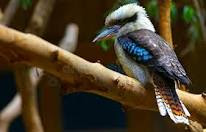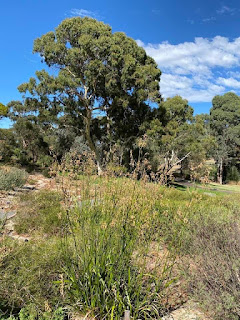Judy. When we decided to come to Adelaide, we also decided to take a quick trip down to Tasmania and put a new Australian state on our map. Last week we packed a few things, took the train to the airport, and hopped a plane to the island state off the coast of Australia.
Ok--truth here: I expected it to be all forests (bush, I should say in Australia), and Tasmanian Devils waiting to chase me down. Yes, I am embarrassed to admit that.
What we found, when we arrived in Hobart, the capitol, was a busy city with charming old repurposed buildings next to modern ones, a port city with plenty of tourists and lots to see.
 |
| A very busy Salamanca market |
On our first morning we got up in time to visit the Salamanca Market, a "must see" artists' market by the port. We got there pretty early, and it was already busy. Ted took off to a nearby park while I roamed the booths, finally settling on a pair of opal earrings--my version of a t-shirt that proudly proclaims "AUSTRALIA." Much classier, I'd say.
 |
| Greg and Ted atop kunanyi |
As we finished up, Ted contacted Greg, mutually introduced to us by our friend Carolyn in Georgia. Greg is a former geography and history teacher, and, whisking us off to Mt. Wellington (kunanyi in the language of the Indigenous peoples) pointed out the remnants of the ice age, the trees that grow on the mountain, and, finally, the magnificent view of the city.
 |
| View of Hobart |
From there we dropped down to a hotel restaurant by Kangaroo Bay for a delicious lunch before heading into Coal Valley for a taste of the wine country, and finally to Richmond, a lovely old town where early convicts brought into Australia were held and made to work. I was disturbed by the small prison where they were kept, especially by the "solitary rooms." Oddly, Greg told us, while it used to be embarrassing to be descended from convicts, it's now quite chic! They've gotten their revenge! We were enjoying each other so much that we convinced him to stay and have pizza and beer with us at an old pub near our hotel.
 |
| Where convicts were held in Richmond |
 |
| This beautiful bridge was built by convicts |
The next morning we took the ferry to MONA, the famous art museum built by David Walsh, who made his money gambling. Google it--fascinating story! The museum, which is also where he and his wife live, is in an underground building, and houses all kinds of both "accepted" and "controversial" art, from Egyptian mummies to paintings to a "poop machine" (you gotta google that, too) and performance art. Everyone recommended it, and no one could explain it. I can't either, but it truly is not to be missed! Our favorite exhibit was a wall filled with videos of people singing an entire Madonna album. The library was fascinating, too, as was the entire "Abbey Road" studio moved into the building!
 |
| Spider webs |
 |
| Fat car |
Monday morning we visited a more conventional museum, the Tasman Museum, for more history; and that afternoon our Servas host, Sonja, picked us up and took us to her lovely home in the suburbs. We had a great evening learning about each other and eating the coq au vin she made for dinner.
One of the things we love about Servas stays is that we fit into the lives of our hosts. Ted did some repairs for Sonja, and we agreed to accompany her to test drive a camper van she was considering. On the way, we stopped at Puddleduck Vineyard for lunch and delicious sparkling wine--what Tasmania's known for. Delicious on both counts, and fun to eat by the pond with a giant duck in attendance!
 |
| The giant duck looks on as we enjoy our sparkling wine |
Sonja is a breast cancer survivor and is a member of Dragons Abreast Dragonboat Team. This is a worldwide sport, and I've since learned about teams of women around the world. We went to watch the women practice for a race in New Zealand, and were both filled with admiration for these powerful women--the mean age is 70! Of course we went out for drinks afterward and got to know some of the team members a little better.
 |
| Proud to meet these amazing women |
On our last morning, Sonja took us and her friend Catherine to Maria Island for more history, some animals, and a great hike. Views were fantastic, watching Ted stalk a herd of kangaroos to get a photo a delight, and the hike invigorating. It was a perfect end to a great visit.
 |
| Up close and personal with kangaroos |
 |
| Fossil Bay |
 |
| Wombat--which end is which? |
 |
| The painted cliffs |
Sonja drove us to the airport, and we arrived back at our place in Eden Hills about ten that night. We fell into bed, happy and exhausted. And slept nine hours.




















































